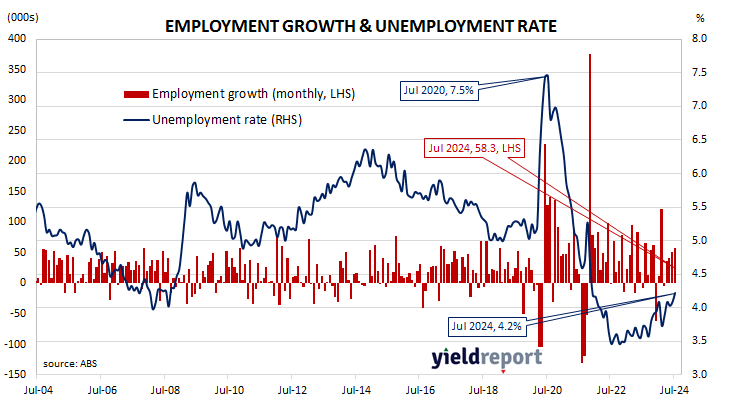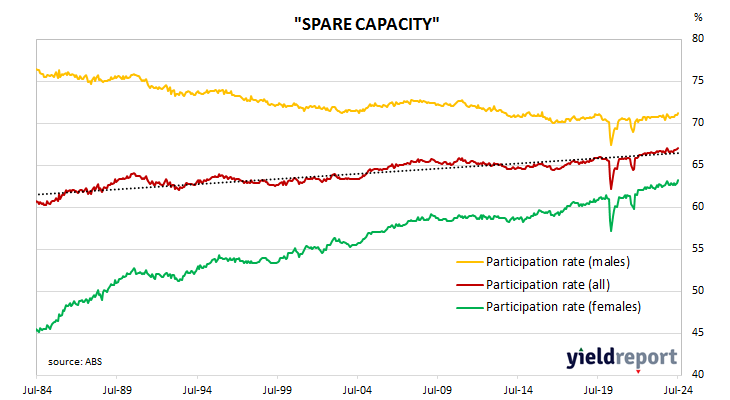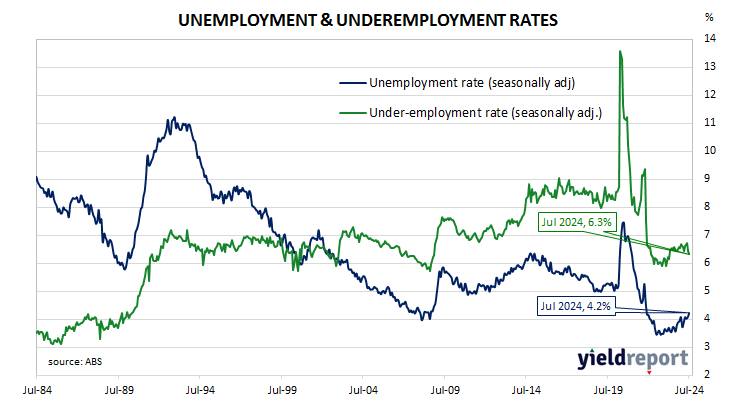Summary: Employment up 58,300 in July, greater than expected; Westpac: results speak to labour market resilience rather than weakness; ACGB yields fall across flatter curve; rate-cut expectations firm; ANZ increases in labour supply continuing to meet/exceed demand; participation rate rises to 67.1%, new series high; jobless rate rises to 4.2%; fewer part-time jobs, more full-time jobs; aggregate work hours up 0.4%; underemployment rate declines to 6.3%.
Australia’s period of falling unemployment came to an end in early 2019 when the jobless rate hit a low of 4.9%. It then averaged around 5.2% through to March 2020, bouncing around in a range from 5.1% to 5.3%. Leading indicators such as ANZ-Indeed’s Job Ads survey and NAB’s capacity utilisation estimate suggested the unemployment rate would rise in the June 2020 quarter and it did so, sharply. The jobless rate peaked in July 2020 but fell below 7% a month later and then trended lower through 2021 and 2022.
The latest Labour force figures have now been released and they indicate the number of people employed in Australia according to ABS definitions increased by 58,300 in July. The result was considerably more than the 20,000 rise which had been generally expected and greater than June’s rise of 52,200.
“Overall, these results speak to labour market resilience rather than weakness, a welcome signal for policymakers that have been desperately trying to orchestrate a ‘soft landing’ for the economy,” said Westpac economist Ryan Wells.
Commonwealth Government bond yields fell across a flattening curve on the day. By the close of business, the 3-year ACGB yield had lost 3bps to 3.47% while 10-year and 20-year yields both finished 6bps lower at 3.88% and 4.28% respectively.
Expectations regarding rate cuts in the next twelve months firmed, with a February 2025 rate cut fully priced in. Cash futures contracts implied an average of 4.325% in September, 4.295% in October and 4.22% in November. February 2025 contracts implied 4.00% while August 2025 contracts implied 3.45%, 98bps less than the current cash rate.
“The participation response does take some of the edge off these data from an inflationary perspective, in that increases in labour supply are continuing to meet, and exceed, demand for labour,” said ANZ Head of Australian Economics Adam Boyton. “That is reflected in the ongoing drift higher in the unemployment rate, despite robust jobs growth.”
The participation rate hit a new series-high after it increased from 66.9% to 67.1% as the total available workforce increased by 82,200 to 15.107 million. However, the number of unemployed persons increased by 23,900 to 637,100 and, as a result, the unemployment rate increased from 4.1% to 4.2%.
The aggregate number of hours worked across the economy increased by 0.4% as 2,300 residents lost part-time positions and 60,500 residents gained full-time positions. On a 12-month basis and after revisions, aggregate hours worked increased by 0.9% as 244,700 more people held part-time positions and 210,700 more people held full-time positions than in July 2023.
More attention has been paid to the underemployment rate in recent years, which is the number of people in work but who wish to work more hours than they do currently. July’s underemployment rate ticked down from 6.4% to 6.3%, 0.4 percentage points above this cycle’s low.
The underutilisation rate, that is the sum of the underemployment rate and the unemployment rate, has a strong correlation with the annual growth rate of the ABS private sector wage index when advanced by two quarters. July’s underutilisation rate of 10.6% corresponds with an annual growth rate of about 4.0%.




